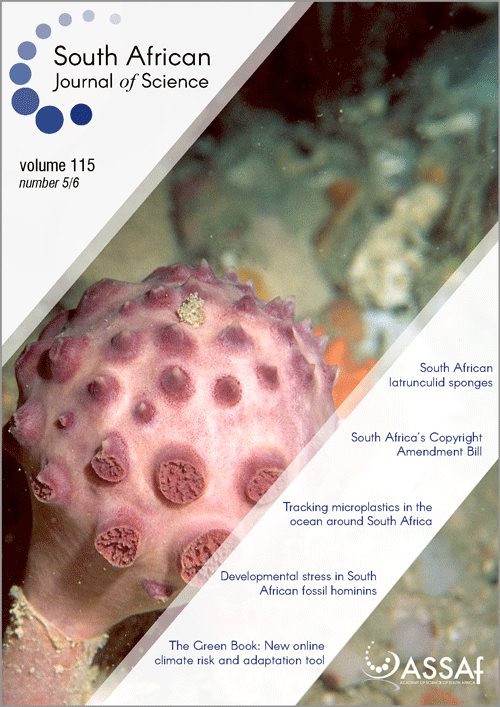Developmental stress in South African hominins: Comparison of recurrent enamel hypoplasias in Australopithecus africanus and Homo naledi
DOI:
https://doi.org/10.17159/sajs.2019/5872Keywords:
dentition, perikymata, ontogeny, seasonalityAbstract
Discovery of a new hominin (Homo naledi) in the same geographical area as Australopithecus africanus creates the opportunity to compare developmental dental stress in higher latitude hominins with low that in latitude apes, among whom repetitive linear enamel hypoplasia (rLEH) recurs seasonally at about 6 or 12 months. In contrast to equatorial Africa, a single rainy/dry cycle occurs annually in non-coastal southern Africa. It is predicted that LEH will recur annually but not differ in duration between ancient and more recent hominins. Data were collected from epoxy casts of anterior teeth attributed to H. naledi (18 incisors, 13 canines) and A. africanus (29 incisors, 8 canines) using a digital microscope, surface scanner and scanning electron microscope. The location, number, width, depth and distance between defects (including perikymata counts and spatial measurements) of 136 LEH events were compared among crown moieties (deciles 4–6 and 7–9), tooth types and taxa. Enamel defects are concentrated in the cervical half of anterior crowns, and in similar numbers in each taxon. Contrary to expectations, H. naledi show bimodal LEH durations reconstructed at about 2 and 8 weeks compared to just 4 weeks in A. africanus. Both taxa show bimodally recurrent episodes of LEH centring on 2 and, more commonly and severely, 6 months. A combination of two independent annual stressor types, one disease and one seasonal, could explain the observations. These estimations of duration and recurrence of developmental stress require evaluation using actual perikymata periodicity for H. naledi and more refined understanding of palaeoenvironments for both taxa.
Significance:
- Seasonal stress is a central concern in the biological and health sciences. Because of the innate way that enamel is deposited, the timing of stress in the childhood of apes, modern humans and their fossil ancestors can be measured with a precision of about 1 week.
- Application of this method to South African Pliocene Australopithecus africanus and Mid-Pleistocene Homo naledi reveals that, unexpectedly, both forms show semi-annual stress – a finding that is tentatively attributed to two independent annual stressors, possibly disease and malnutrition.
Published
Issue
Section
License

All articles are published under a Creative Commons Attribution 4.0 International Licence
Copyright is retained by the authors. Readers are welcome to reproduce, share and adapt the content without permission provided the source is attributed.
Disclaimer: The publisher and editors accept no responsibility for statements made by the authors
How to Cite
- Abstract 1471
- PDF 794
- EPUB 232
- XML 438












.png)